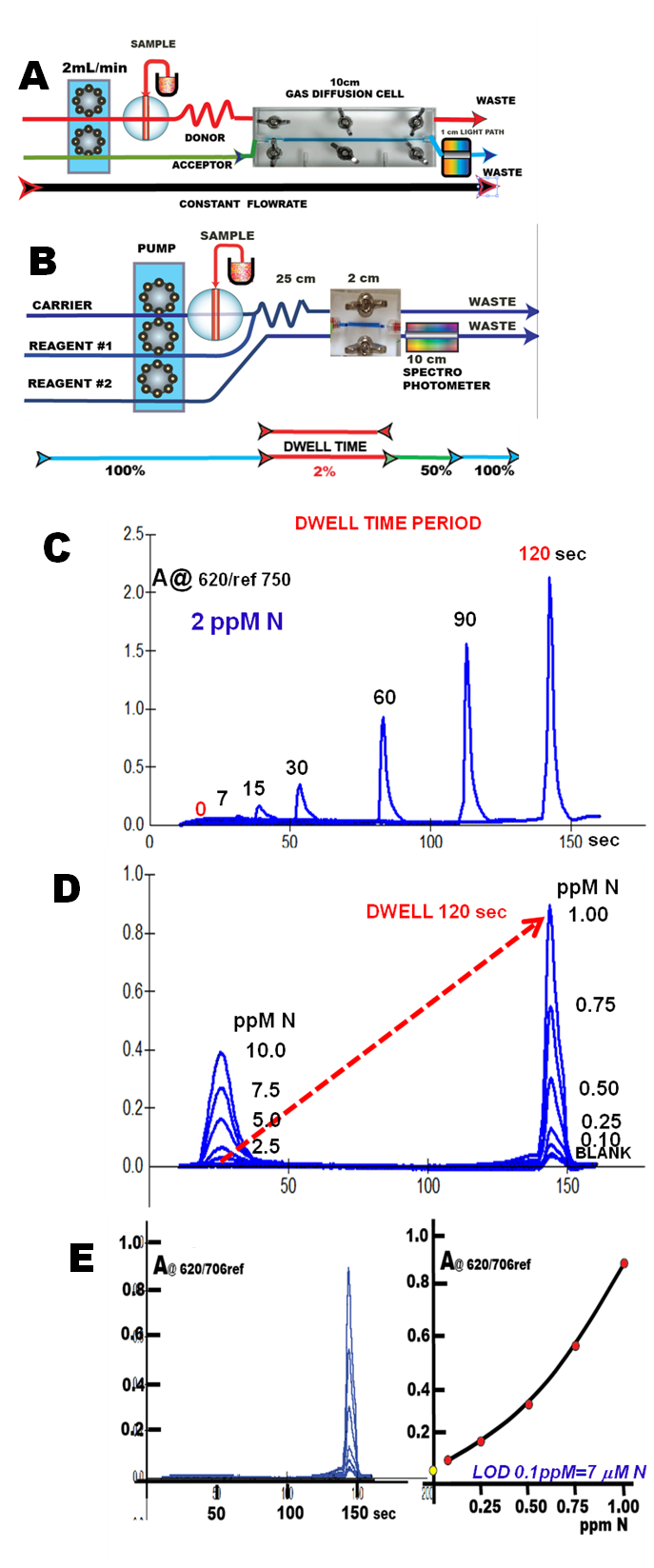Gas Diffusion in Forward Flow pFI Format
Flow based gas diffusion techniques are well suited for separation of volatile species form aqueous solutions. Sample, injected into an stream releases target analyte that diffuses across a membrane from donor (red) to an acceptor (green) stream, into a suitable reagent for subsequent measurement. Hydrophobic membranes, serving as an air gap barrier allow ammonia, carbon dioxide, sulphur dioxide, chlorine, ozone, hydro cyanide, ethanol, acetic acid, hydrofluoric and hydrochloric acid as well as many other volatile compounds, (Luque de Castro 1998, 2008) to be selectively separated from complex aqueous matrices, and determined either by spectrophotometry or by eletrochemical detection. Replacing the constant flowrate (A) by programmed flowrate (B) allows miniaturization of gas diffusion module from 10 cm long diffusion membrane to 1`cm long, while increasing sensitivity and improving LOD of an assay. The following assay of ammonia serves as a template for further applications of this selective method.
When ammonium containing sample is merged with a basic (pH > 11, reagent #1) solution (B), NH3 is formed. The NH3 passes across a gas-permeable membrane into a acceptor stream (reagent # 2) containing bromothymol blue in acid (yellow) form. Collection of NH3 in acceptor solution raises the pH, and the color change (to blue) is proportional to the initial ammonium content in the sample.
Because the diffusion of ammonium across the membrane is the rate determining step. the flow rate is programmed to slow down, while sample zone is in contact with the diffusion membrane. Thus by increasing the dwell time at a 2% flow rate, (C) the amount of ammonia transported through the membrane increases, and so does the intensity of the color of the indicator. By changing from cFI (0 seconds Dwell) to pFI (up to 120s Dwell), the sensitivity of measurement increases 20 times. (D) The nonlinearity of calibration curve is due to response of indicator at this pH range (E).
Sample volume 300mcrL, flow rate 2% at dwell time 120 sec, flow rate 50% trough flow cell, 10 cm light path, 2 cm diffusion path. 0.0005% BTB indicator.
M. D. Luque de Castro & I. Papaefstathiou, TRAC, 17, 41, (1998)
M.D. Luque de Castro , Membrane Based Separation Techniques, Dialysis, Gas Diffusion and Pervaporation.
Ch 8 in S. D. Kolev, I. McKelvie, Ed. Advances in FIA and Related Techniques. Elsevier , Amsterdam 2008
1.2.23.










